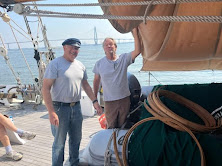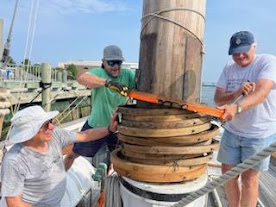Thursday afternoon turned out to be a productive afternoon aboard Spirit of South Carolina. Giving ourselves just two hours, Eli Bundy and myself teamed up to lay a coat of Interlux 1026 Primer-Woodsealer onto the mainsail boom,, all 52 feet. It turned out the be the perfect 2-hour project for a late afternoon, sea breeze barely noticeable, and summer sun being, well, very bright. When the next Volunteer crew musters later this week, the next step may very well be only one second coat of sealer, then a first coat of Interlux 96 Schooner Varnish. When all you volunteers who are used to laying down a total of 20 total coats of Deks-Olje sealer and varnish, start in with this Interlux stuff, I think you'll be pleased.
Saturday morning; It was looking promising. After filling the water jug with ice and water, I called muster just forward in the shade of the foresail boom awning. In spite of the sweltering forecast ahead, I knew it was gonna be a great day when 3 things started to converge at muster.
1. at 0900, 7 Volunteers mustered at the mainmast. Count 'em. Seven! Oh, the potential amount of stuff we could accomplish!
2. One of our stalwarts, Dave Lazar, squints up to the main mast spreaders and says, "Okay, I'm ready, lets do it." For weeks I"d been needling, cajoling about his getting into a boson's chair and seeing the harbor from 80 feet in the air (oh, and the masts needed sanding), he was "disinclined to acquiesce."
But today he was looking at the top 3rd section with a steely gaze full of resolve. Tony Marchesani immediately takes the que, grabs Dan Maurin and they immediately go hunting for the bosuns chair, bridle, harness and tag lines. Having spent several past Saturdays slowly advancing the project of sanding down the fore and main masts for linseed oiling, they knew exactly what to do.
3. Three new volunteers are left standing in front of me. Two of them, Julie, and Gerin Choiniere are from out of town, but both have a great history on other tall ships. Julia as stood before the mast on the topsail schooner, "Amistad", albeit awhile ago, while Gerin, mentions three other tall ships in his recent past including "Gazela," a Barqentine out of Philadelphia. Our third volunteer, Brian Ferris, has no experience sailing(yet) but is highly motivated to start anywhere learning.
So, first things first, each new volunteer is handed a parking permit card, to immediately place in their car. I invite Julie and Gerin to take their own self-guided tour of the vessel, acquaint themselves with the deck layout, belowdecks compartments, and her rig. Meanwhile, Brian and I start our own tour at the most basic level, starting at the bowsprit, moving aft. Brian has already skimmed thru the Crew Manual, online, so he's getting the gist of things.
We've not yet completed the tour when challenges occur at the bosun's chair on the main mast. Julie and Gerin have already laid in alongside Tony and Dan on the halyard and boat falls lifting and steadying Dave in the bosun's chair now suspended 20 feet above us. This lift up the mast is particularly complex because the mast is raked aft, and the only lift tackle sufficient to haul up a human's weight is the throat tackle. Problem is, Dave's project is, using a power orbital sander he's brought up with him, to sand the grime off the forward half of the mast,, the side opposite from his lifting tackle is positioned. Therefore his lifting tackle always wants to pull his bosuns chair back around to the aft side of the mast.
To keep Dave in his chair positioned on the forward side, Dan had rigged the Small boat falls onto the bosun's chair and set tension in a forward direction, keeping the seat positioned on the forward side of the mast. However, as the chair was raised higher up the mast, the direction of pull was steepening, reducing his leverage.
 |
| New Volunteer Brian tending the Small Boat falls |
 |
| Dave Lazar in the bosun's chair, managed by 3 lines to maintain position on forward side of the mast. |
At the same time, new Volunteer Brian, and Gerin moved his Small Boat falls line over to the dock where they could create a stronger more lateral angle to hold Dave on the forward side of the mast.
 t t |
| New Topman, Dave Lazar fresh off the bosuns chair after a long hot morning aloft. |
After downing lunch and much swigging of ice water and Sprite, the crew was back on deck circled around the huge canvas role that was the jib. Flushed with our successful morning, and Gerin's assurance that he could have the luff all lashed to the jib stay by 3 pm. This was going to take some All-hands team work. The mass of canvas weighed 250 pounds, and when unrolled, stretched 35 feet from tack to head.
Teamwork and Bending on a big Head Sail.
Too bad we had no idle hand with a cell phone video because(except for one small part) we were about to kill a Master Class on how to bend on a Jib sail. While three of us rolled out the jib and reshaped it into a 35 foot-long skinny burrito, another gathered up and threw in a handfull of gaskets to hold it together. Someone else went below into a locker to find the right sized roll of seine twine, to be cut into 30 lengths a fathom-each. Another found the halyard, unshackled the block and ran it forward to the "burrito"s middle gasket to take the weight of the canvas Gerin laid out on the headrig to pull loose all the residual lashings still clinging to the rings, and overhaul the jib downhaul line to make it fast to the tack at end of the "burrito."
 |
| Julie at the anchor, Bryan on the Bowsprit and Gerin on the Jib. |
As Gerin finishes the last lashing down by the tack, some hands start securing tools and other gear back in their place while rest of the crew gathers at the knightheads to lay out on the headrig and attempt to work in a harbor furl. The end result isn't admirable, but it's functional, and.. For cripes sake, this crew has have been in this sun heaving, tugging, pulling and lifting for two straight hours. We'll have it sharp next muster, or maybe when we take on the Jumbo.
Like I said,, they made it look like a master class in sail rigging.. oh yeah,, I guess I did say something about one small part. Well, next time we muster together,, BMABAITY

















